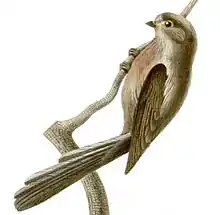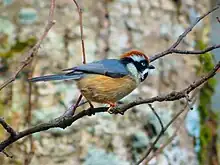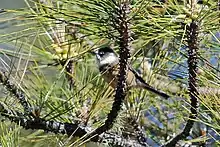Aegithalos
Aegithalos is a genus of passerine birds in the family Aegithalidae (bushtits), encompassing majority of the species in the family.
| Aegithalos | |
|---|---|
 | |
| Long-tailed tit (A. caudatus) | |
| Scientific classification | |
| Domain: | Eukaryota |
| Kingdom: | Animalia |
| Phylum: | Chordata |
| Clade: | Dinosauria |
| Class: | Aves |
| Order: | Passeriformes |
| Family: | Aegithalidae |
| Genus: | Aegithalos Hermann, 1804 |
| Type species | |
| Pipra europaea[1] = Parus caudatus Hermann, 1804 | |
| Species | |
|
10, see text | |
| Synonyms | |
|
Orites G.R.Gray, 1841 (non Keyserling & Blasius, 1840: preoccupied; non Moehring, 1758: suppressed) | |
Taxonomy
The genus Aegithalos was introduced in 1804 by the French naturalist Johann Hermann to accommodate a single species, the long-tailed tit.[2][3] The genus name was a term used by Aristotle for some European tits, including the long-tailed tit.[4]
Species
The genus contains following ten species:[5]
| Image | Common Name | Scientific name | Distribution |
|---|---|---|---|
_(34979902626).jpg.webp) | Long-tailed tit | Aegithalos caudatus | northern Europe and the Palearctic, into boreal Scandinavia and south into the Mediterranean zone |
 | Silver-throated bushtit | Aegithalos glaucogularis | central and eastern China and south towards Yunnan |
 | White-cheeked bushtit | Aegithalos leucogenys | Afghanistan, Kashmir region, and Pakistan. |
 | Black-throated bushtit | Aegithalos concinnus | foothills of the Himalayas, stretching across northern India through north-eastern Bangladesh, Nepal, Bhutan, northern Myanmar, Vietnam, and Taiwan. |
_JEG9985_(cropped).jpg.webp) | White-throated bushtit | Aegithalos niveogularis | India, Nepal, and Pakistan. |
.jpg.webp) | Rufous-fronted bushtit | Aegithalos iouschistos | eastern and central Himalayas in Bhutan, China, India and Nepal |
_(18017149158)_(cropped)_2.jpg.webp) | Black-browed bushtit | Aegithalos bonvaloti | mid-southern China and far northern Burma. |
 | Burmese bushtit | Aegithalos sharpei | southwestern Myanmar. |

| Sooty bushtit | Aegithalos fuliginosus | central China. |
.jpg.webp) | Pygmy bushtit | Aegithalos exilis | Indonesia |
Fossil record
References
- "Aegithalidae". aviansystematics.org. The Trust for Avian Systematics. Retrieved 2023-07-15.
- Hermann, Johann (1804). Observationes zoologicae quibus novae complures, aliaeque animalium species describuntur et illustrantur (in Latin). Argentorati [Strasbourg]: Amandum Koenig. p. 214.
- Paynter, Raymond A. Jr, ed. (1986). Check-List of Birds of the World. Vol. 12. Cambridge, Massachusetts: Museum of Comparative Zoology. p. 52.
- Jobling, James A (2010). The Helm Dictionary of Scientific Bird Names. London: Christopher Helm. p. 33. ISBN 978-1-4081-2501-4.
- Gill, Frank; Donsker, David; Rasmussen, Pamela, eds. (July 2021). "Bushtits, leaf warblers, reed warblers". IOC World Bird List Version 11.2. International Ornithologists' Union. Retrieved 7 December 2021.
- Kessler, E. 2013. Neogene songbirds (Aves, Passeriformes) from Hungary. – Hantkeniana, Budapest, 2013, 8: 37-149.
This article is issued from Wikipedia. The text is licensed under Creative Commons - Attribution - Sharealike. Additional terms may apply for the media files.